
..........................................................................................................................................................................................................
going the wrong way
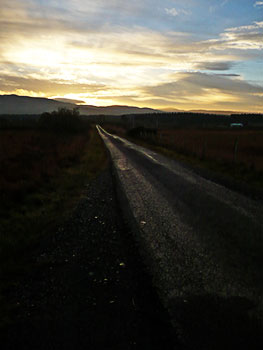
in common with thousands of cyclists all over the world, the minimal membership of velo club d'ardbeg partakes of a regular sunday morning ride. this is a weekly event that defies all restrictions that would more commonly have participants reaching for the coleman's mustard book of excuses (such a book does actually exist). for example, last saturday eve i was called upon to supply my percussive skills to an evening soiree in an hotel several miles from home. despite arriving back at a totally fictitious hour of the morning, i still arose at the appointed hour in order to extricate the colnago from its resting place and head to deb's for the usual sunday morning rendezvous.
and 'tis not just i willing to forgo the customary eight hours repose in exchange for a morning on the bicycle. lord carlos of mercian was, i'm led to believe, attending a dinner party this saturday eve past, a function that may just have incurred a modest degree of alcoholic imbibing till the wee small hours. i know this, for on returning to deb's, the party host complained of a headache that had not been there several hours previously.
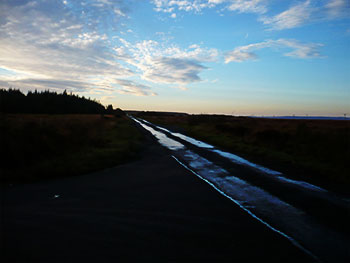
we were simply a trio of riders this morning and willing to test the theory that in our impending dotage, we seemed only to be riding more quickly than conditions would normally dictate. meeting time of a sunday morning has long been 10am, usually allowing for a good couple of hours and a bit to survey the estates before the aroma of freshly ground coffee draws us back to our initial point of departure. the sunday ride has been a factor of cycling life on the isle for almost a decade, so on an island that measures approximately 21 miles top to bottom and a similar amount left to right, almost split asunder by two sea lochs in the middle, it will come as little surprise that we have explored pretty much every square inch more than just the once.
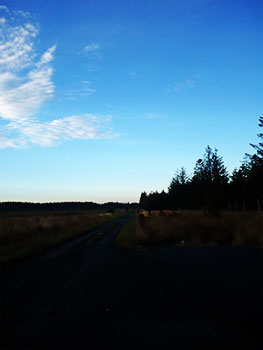
at first, we thought it mere familiarity. though the seasons bring changes in landscape and weather, it often seemed that our travels hither and thither were passing more quickly by the week. an optical or horological illusion at best. however, the horological factor bore witness to the fact that we were, in fact, getting around the principality substantially quicker than had hitherto been the case. in fact, it was remarked upon by the incumbents supping coffee at the ride's terminus. time was, we were told, that they could order coffee and a piece of millionaire's shortbread and consume both at a comfortable pace while still having left the building before those dastardly men in lycra put in an appearance.
it was not long before we were catching them unawares.
there was/is of course the distinct benefit of subsequently reaching home in time to view the weekend's 'cross race from europe, or in the past, to catch the bulk of a stage in the tour de france or vuelta. but still, there's a certain piquancy to arriving home from the sunday ride with legs that know they've been for a decent bike ride. the joy of feeling that muscularity creak ascending the stairs for a shower is something only the practiced pelotonese will initimately know. the fact that such was no longer a feature began to indicate that we were perhaps not expending ourselves to our full potential.
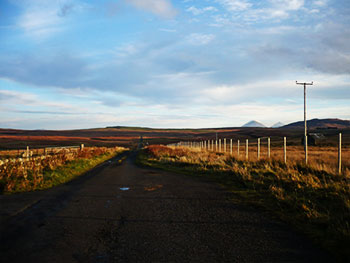
of course, the cure was staring us in the face all the time.
ride further.
and that, you will be happy to hear, is exactly what we did this morning. after suffering the iniquities of the abattoirenberg forest road, we hung a left instead of a right, adding around an extra 18km to the loop and creating a split in the peloton come the sprint at bruichladdich's 40mph sign. understandably, the soya cappuccino at the end tasted better than ever.
i'm sure those stairs are steeper than they used to be.
monday 22nd october 2012
 ..........................................................................................................................................................................................................
..........................................................................................................................................................................................................a material girl
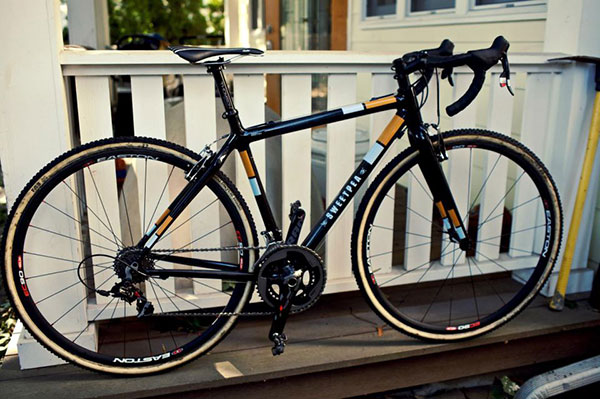
grab yourself a packet of freshly roasted coffee beans in portland town and throw them as hard as you can in any particular direction you may care to choose and the chances are you'll hit a bicycle framebuilder. well, maybe not the actual framebuilder, but possibly one of the windows in their workshop. the place is threaded with frambuilders, many of them now household names, always assuming the household knows a thing or two about bicycles. tony pereira, sacha white's vanilla, ira ryan, chris king's cielo and natalie ramsland's sweetpea to name just a few.
maybe the packet of coffee beans is a tad far fetched; maybe hanging a city-sized electro magnet over any random region would be likely to garner more than just a smattering of columbus, reynolds, and kva steel tubing. for the lads and lasses of portland's bike builder community are well-versed in the ways of the brazing torch and the tig welder. steel is the material of choice for a great number of reasons, but mostly because it's readily available. with a rainfall almost the equal of islay, it seems possible that one of portland's principal by-products is ferrous oxide.
however, also living and working in the city are the carbon fibre junkies at ruckus components. i first came across ruckus when trying to find somewhere that might refurbish the rear dropouts on my colnago c40 which have all but turned to aluminium powder due to the extremes of weather on the west coast of scotland. matt seaton at the guardian, currently ensconced in new york e-mailed to say the chaps at ruckus had made a beautiful job of repairing similar wear on the dropouts of his colnago ct1. i was subsequently introduced at this year's north american handmade bicycle show in sacramento.
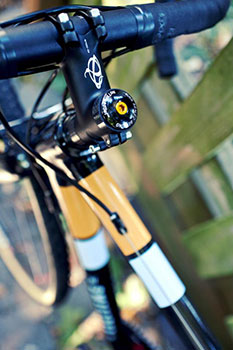
it seems you can't keep a good woman down, and only a few weeks ago, the saviour of custom made women's frames in portland, natalie ramsland brought to light a carbon cyclocross sweetpea bicycle named the tactical boom boom. something of a surprise, i'll admit since the last time i met natalie, her workspace was most defnitely filled with steel tubing, a hefty vice bolted to a workbench and the gas cylinders beloved of the city's framebuilders. since the phrase 'steel is real' could have been invented for portland, what prompted the move to carbon?
"Our mission as a company is to get more women on bikes that fit them beautifully. I started building in steel because that is the method that I had the opportunity to learn, and also because it gave me the ability to deliver a custom fit. I will always love building with steel, but I am completely open to exploring new materials as long as I can still deliver an exquisite fit."
a similar sort of question might be asked of shawn small. he, along with graham adams comprise ruckus. with a reputation of being the go to shop for anything out of the ordinary in carbon fibre, how did he start, and why in a town full of steel framebuilders?
"I started as a tinkerer in Wisconsin, then went on to college for Mechanical Engineering. I worked as an engineer in Milwaukee, then struck out on my own for Portland.
"I've always been interested in composites. So light. So strong.
"I've also always been interested in bicycles. So with the way the bike industry has been going, it was a no-brainer to combine my two interests and start my company. I started Ruckus with the idea of producing custom composite bicycle parts in the United States. Carbon repairs started organically. As I immersed myself in the cycling community in Portland, and people learned I could repair carbon, they started asking for a favor to fix their broken frames. Eventually it turned into a serious business.
"Being in a town full of steel has never been a problem for us. The cycling industry in this town has room for a lot of incredible builders and craftsmen across all materials. We love seeing it all and are tickled pink to be a part of it."
unlike many of the city's builders, immersed in the world of the custom build for specific clients, sweetpea offer specific ranges of bicycles with identifiable names. it's not too long since i mentioned the marque's farmers' market; others include the little black dress, subsetted into the love and lust ranges. this first carbon fibre offering has been monickered the tactical boom boom, a name that seems certain to confuse as much as inform. why call it so?
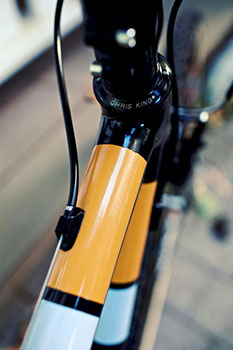
"We named our original cyclocross bike the Boom Boom. And when we first talked about this project with Ruckus, they were really excited about a ballistic grade carbon bonding process. This idea of a battle-worthy carbon cyclocross bike was a perfect match for the motto of my cyclocross team The Sweetpea Ladies' Auxiliary "Battle and Friendship" and the Tactical Boom Boom was born"
as i mentioned above, up till now, i had classed natalie as one of the more prominent portland framebuilders working in steel. but now the name of ruckus has reared its carbon fibre head. in the case of the tactical boom boom, who approached who?
"Ruckus approached me about a year and a half ago with the vision of growing carbon manufacturing in the US and asked if I wanted to collaborate on a bike. I thought it was a great opportunity to explore designing for a new medium and new market, but the mad scientist charms and honest enthusiasm of the Ruckus fellas made it easy to dive in to the process."
ruckus, however, have a more deserved reputation for doing magical things with carbon; repairing, conceiving, moulding and all manner of objectives that you'd think couldn't be done. over the years, in the process of trying to find someone willing to effect a repair on my c40, i had drawn a compete blank. even colnago were unwilling or unable to assist, so i had resigned myself to the fact that, despite the majority of the frame being close to immaculate, it was perhaps time to think land-fill.
however, the sweetpea carbon fibre, to state the obvious, is a complete bicycle, something of a departure for ruckus. is this the first time shawn has collaborated on a complete bicycle? "No. We collaborated to build one-off frames for manufacturers and we've worked on frame modification prototypes for manufacturers."
even those with minimal knowledge of how bicycles are made cannot fail to consider that there's something of a difference between carbon construction and that of steel. the latter is acquired in lengths of bare tubing, selected according to the requirements of the end product. carbon fibre tubing, on the other hand, can be almost infinitely tweaked at the layup stage before being joined together in a manner quite some distance from the brazing torch or tig welder. how does a girl used to brazing steel frames go about constructing a carbon frame, and perhaps more to the point, why?
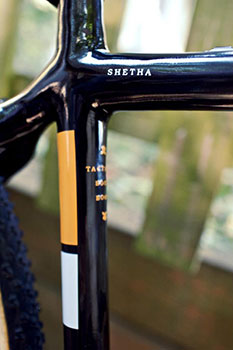
"I love brazing. I love working with steel. As a fabricator, that is my medium. But there is another side of my craft that is about design, and by working with a carbon partner like Ruckus, I can produce a broader spectrum of Sweetpeas than my own palette holds."
carbon fibre owns a wide range of construction and joining methods, allowing for some interesting (to say the least) tube shapes and more than just a few options for subsequently joining them together. colnago still opt to produce their italian made frames using carbon tubes and lugs, similar to traditional steel frames but substituting glue for that of molten brass at the joining stage. the bulk of carbon frames, however, mostly emanating from the far east are of monocoque construction. two halves of a mold are layered with pre impregnated (with resin) carbon fibre matting the results of which are joined together after each mold has been appropriately cured.
which process had shawn used for the sweetpea fabrication? is it a monocoque or tubes and wrapped lugs? "For the Tactical Boom Boom we did a tube to tube design with wrapped lugs. ENVE made the tubes and the rear end. We took the geometry that Sweetpea gave to us, carefully mitered and laid up all of the tubes in our Arctos jig and carbon wrapped and formed each lug on its own."
given their renowned expertise with carbon fibre and the nature of sweetpea's reputation for a custom fit, had shawn required to invent any new stuff to complete the build? "Every day we are inventing new processes, or better ways to do things, so we drew from our experience. But we knew what processes and materials we wanted to use for the Tactical Boom Boom, so we didn't have to invent anything."
i'm interested, however, how this collaboration worked between ruckus and sweetpea. did natalie simply hand shawn the drawings and leave him to it, or was she just as hands on as ruckus? "Natalie fitted and designed the frame, then together we collaborated on what headtube, dropouts, bottom bracket shell and cable routing we wanted to use. With all of the design criteria in hand, we chose the tubes, and layup schedule of the carbon fiber. While we were working on producing the frame, Sweetpea was designing a (really good looking) paint scheme. They sent it over to us, and we painted it (something we have years of experience doing)."
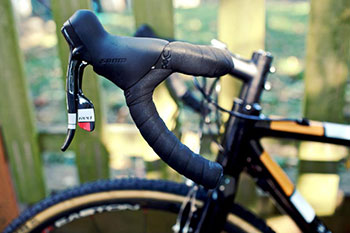
take a tour of any of the islay whisky distilleries and you'll find that several feature beautifully constructed wooden washbacks in which the brew is fermented. in fact, in a moment of serendipity, those at ardbeg distillery are constructed from oregon pine. however, one or two use stainless steel, and there's a distinct possibility that, during the tour, the guide will offer reasons as to why one is better than the other. in point of fact, no-one really knows, for there has never been any direct comparison within the one distillery and nor will there ever be in case it upsets the nature of the blend.
however, in the interests of figuring out whether steel is better than carbon by direct comparison, does natalie have a steel tactical boom boom that would allow this to happen? "The steel-with-carbon-fork Boom Boom is designed to be a race-ready cyclocross bike that lives an active life as a winter training bike. It features mechanical disc brakes, plenty of mud clearance, a moderate bottom bracket drop for stability and comfort on the road. The Tactical Boom Boom is more of an unabashed racer - stiff, light, fast. Both models are built around custom fits."
setting up a range of carbon bikes is a notoriously expensive procedure, particularly in terms of monocoque construction where a separate mold is required for each incremental frame size. a lugged build is slightly simpler, but if the angles change, a range of different lugs will also be required. there's little doubt that the ruckus method allows for a greater degree of flexibility, but is it still possible to offer a custom fit? in other words, are these made to measure or is natalie intending to simply offer standard sizes?
"We follow the same custom design process for the Tactical Boom Boom as we do for all of our custom bikes. So these are all custom from start to finish.
"For women cross racers, getting a bike that fits well can be the biggest challenge and the biggest upgrade opportunity. It seems that traditionally, fit is the biggest compromise women make with their cyclocross bikes. The difficulties that average-sized, let alone small women face in getting a road bike are exacerbated by cross bikes because of their higher standovers, larger tires, and longer forks. That's why the Boom Boom and the Tactical Boom Boom are designed for the ideal riding positions of each customer."
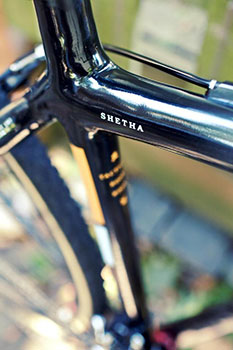
the nature of each separate range of steel tubes from different manufacturers are relatively well-known. this allows for the combination of differing flavours adding up to someone's ride of their life. carbon, though infintely variable, surely has the ability to confuse as much as confirm. how did shawn figure out in advance just how the bike might ride?
"We have been inside and out of just about every single carbon bike on the market, so when it came to making one ourselves, we knew just where we wanted and what we didn't want. With Natalie's ability for fit and design and our knowledge and experience in carbon fiber, we knew we would have a great riding bike."
one or two framebuilders of my acquaintance built, dismantled and rebuilt a whole series of steel frames before having the confidence to pronounce to the world that they'd got it right. call it research and development, if you will. did graham have to complete several revisions of the tactical boom boom, or did ruckus get it right first time?
"This stuff isn't cheap, so it's essential to get it right the first time. We've seen first-hand through our repair business what NOT to do when constructing a frame. Natalie got it right with her specs, and we got it right with our build. Then we pointed to the fences and knocked it out of the park with the collaborative paint job."
many an experiment has been undertaken simply because the opportunity presents itself in a useful package. that, however, does not guarantee that the results will be as desired; just as many motorways have resulted in cul de sacs, never to see the light of day again. is the tactical boom boom likely to be the first of many carbon frames from sweetpea? "Wouldn't that be great? Stay tuned."
not really wishing to become what i believe might be referred to as devil's advocate, but if ruckus performed the bulk of the grunt work in response to natalie's sweetpea designs, is there any likelihood that we'll see a ruckus carbon bike all of their own in the near future?
"This is a tough question. Can we do it? Yes. We're racing on a carbon, disc brake prototype we built right now. As a brand, we are still trying to figure out if this is a good idea. Just because we can make it, doesn't necessarily mean we should.
"We're inventing new things and designing new products for custom one offs and this is some of the most exciting work in the bike biz. However, we only have so much time in a day. I would say that building a couple of custom frames a year is a pretty fun project for now."
carbon fibre cyclocross frames are, dare i say it, ten a penny these days. perhaps not as low in cost as a penny, but i think you catch my drift. custom-made, custom fit carbon cyclocross frames, however, are likely as rare as hen's teeth, perhaps bringing with them a concomitant price tag. in order that we might garner a rough idea of just how full that piggy bank might need to be before the order is placed, what's the retail cost of the tactical boom boom?
"These bikes aren't officially part of our Lust Line of bike models yet, but anyone interested in purchasing a Tactical Boom Boom should contact us. We'd be happy to get something started."
truly, it's unlikely you can say fairer than that.
sweetpea bicycles | ruckus components
sunday 21st october 2012
 ..........................................................................................................................................................................................................
..........................................................................................................................................................................................................behind the stare by geoff proctor. deeds publishing 312pp illus. $19.95

'Slivers of sun angle through rowed pine trees on a quiet road. The trees crown a canopied ridge with verdant meadows sloping off in both directions. Wisps of condensation dance off the warming pavement. Down the shady ridge side, mourning doves woo-woo and, faintly, a lone rooster crows. Somewhere on the sunny side, a farmer's tractor revs and a carpenter's hammer pounds home. Another day begins.'
i'm sure they're still available in toyshops and novelty shops, but does anyone remember those games that consisted of a pile of iron filings and a pen with a megnet at the end? under a clear plastic cover was a caricature of a man's head minus any hair, either on his head or that of a beard. the trick was to create a hirsute portrait by dragging those iron filings around, all the while keeping the picture still to avoid a clump of filings falling to the bottom and leaving a bald patch. hours of endless fun could be had in the back of a car heading to an unknown holiday destination. it put paid to choruses of 'are we there yet?'
when several years older, though placed in a class for higher chemistry deemed less than clever enough to achieve such a certificate in a single year (probably quite correctly), i can recall a chemistry teacher making mention of osmosis, the movement of molecules through a sem-permeable membrane in an attempt to even up the concentration of a solution that existed outside as well as inside. i've since come across the latter with a slightly differing variation of meaning, often used to imply that knowledge of a particular subject has arrived at a distant destination seemingly without two points ever connecting in the middle.
either of the two apparently disparate methods mentioned above could be applied to the mushrooming existence of quality cyclocross in north america when related to the obsessive objectivication of cyclocross in belgium. having experienced at first hand the enthusiasm that exists for 'cross in locations such as portland, as well as that of richard sachs on the eastern seaboard, i confess to a quizzical curiousity as to how a european branch of the sport had reached so far, having seemingly by-passed the united kingdom.
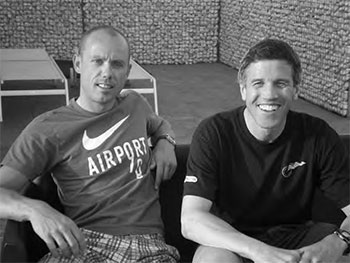
this is not to suggest that cyclocross has ignored and been ignored by britain, but it does raise a slight smile that the three race rapha supercross series starting this weekend after a successful first outing in 2011, is an attempt to bring the joys of american 'cross to the uk. and this while belgium is but a matter of miles across the channel. though there are possibly others who could share the blame, one of the principal protagonists in bringing enthusiasm for cyclocross to the usa is jeff proctor. the man has been involved in competitive cycling for over twenty-five years, currently serving as national junior/under 23 cyclocross coach as well as a director of eurocrosscamp. additionally, in 2009 he was appointed to a four year term on the uci's cyclocross commission. a man who loves his 'cross.
it has often been said that those who can, do, while those who can't, teach. similarly those who do, cannot necessarily write about it. if i might step back a paragraph or two, the teacher responsible for having to suffer me for two years of chemistry was exceptionally well-versed in the subject, but was less competent at teaching others. so despite geoff proctor's undoubted qualification to teach cyclocross, can he translate that to the written word?
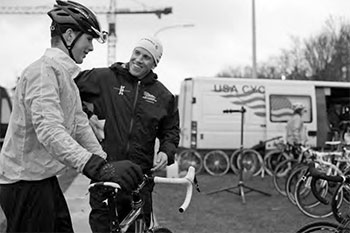
'Maybe it's because we have to come from so far away, overcome so many odds, put up with so much shit, just to toe a World Championship start line.'
i think it worth recording that, on the basis of his opening chapters, i had serious doubts. though i reviewed this volume in its e-book incarnation for reasons of pragmatism, i prefer paper and ink. i don't find the pixelated reading experience to hold the same fascination as the real thing, so i was willing to give the benefit of the doubt and put it down to the medium. however, as the chapters were consumed, behind the stare morphed into a compulsive if quirky read. and in this case, quirky is very good indeed.
strangely, in terms of modernity, the narrative is a tad dated, featuring belgian cyclocross racing from 2008. i am well aware of the procrastination involved in the publishing process, but quite a lot has taken place in the world of 'cross in the past four years, surely such a time-gap works against proctor's dissertation? you would be forgiven for taking such a stance, but in fact that is most defintiely not the case. though his writing always contains just a hint of one-upmanship ("Having known Erwin for over ten years now, there's a conversational comfort I appreciate deeply."), i think it more likely that proctor still finds it hard to come to terms with how easily he is welcomed into the belgian cyclocross inner circle.
proctor has also a slightly eccentric writing style that you'll either love, or perhaps hate. for my own part, i figure it serves his purposes well, creating an almost tangible sense of involvement in the sport, even though manifestly constrained by the printed page. to wit:
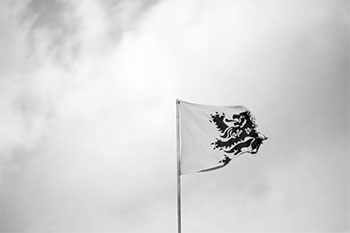
"Then, five minutes of something altogether else-
Engine room cycling.
Muscle it. Slog it. Get on top of it.
Sand. Side-hill. Bog.
40 rpm.
Average speed-19 kph.
Course width‹eight meters across in places.
Pick a line, any line.
No matter. Sludge puddles a meter deep play no favorites.
"Hey, coach, I need a break. Sub me out."
"Sorry, son. No bench."
There are no domestiques. Or excuses. Or places to hide.
tough the bulk of the storyline takes place in belgian, following the likes of stybar, vervecken, boom and nys et al from 'cross race to 'cross race over successive weekends, proctor never forgets his roots, bringing the subject back to the good old us of a in a commendably subtle manner. belgian cyclocross bears only a superficial similarity to that of north america; participation is the greater across the pond, but the colossal number of spectators and substantial earnings to be made in europe separate it from its american derivative.
behind the stare gives an inside look at the rigours, personality and work ethic that pervades belgian cyclocross, but from the expert and almost neutral eye of a man with still one foot in america, and a remarkably well-balanced head on his shoulders. not unsurprisingly, he holds conversations with the one american to have made a dent in belgique, ryan trebon. at the time of his writing, trebon was having a difficult time with his team (sunweb) but is now currently riding for the cannondale-cyclocrossworld.com team back in the states. as i pointed out earlier, a lot has happened since 2008.
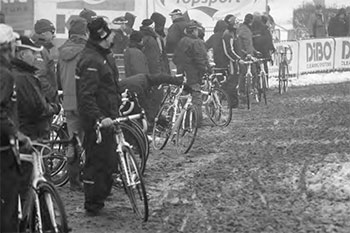
the chapters are relatively short, and though there is a consistent thread running throughout behind the stare, each chapter has the uncanny quality of existing in almost standalone mode. however, if there is one apparent failing, it makes itself known right from the start. the introduction is written by cyclocross colossus, sven nys, presumably translated into english, but also reprised in nys' native language. to do so seems a tad pretentious and unnecessary, but is a foretelling of more to come.
proctor all but worships nys who cannot in his eyes, seemingly, do any wrong. anything sven does takes on superhuman qualities and the portions of narrative that feature the belgian champion take on the mantle of hero worship. i'm not necessarily condemning proctor for this, though i might have preferred it to remain at a more subtle level, for there can be few 'cross fans who do not harbour a certain degree of admiration for both the nys work ethic and subsequent success. geoff proctor finds it hard to conceal his disbelief of being one of nys' confidants (as likely would we all), something which is perhaps overplayed just once or twice too often.

behind the stare is an excellent insight into the machinations inherent in belgian cyclocross at the top level, while offering a delightfully intelligent comparison with the sport's development in north america. geoff proctor may not be a practised author in the accepted sense, but his book is all the better for it. the book has a very clever subtext and an almost concealed brilliance. this may just turn out to be one of the seminal books of its genre, a book that deserves the widest audience from belgium to the usa. and there are a number of salient lessons to be learned by those of us in britain who wonder why cyclocross often seems more of a past-time than a sport.
'George Orwell put it this way: "Serious sport has nothing to do with fair play. It is bound up with hatred, jealousy, boastfulness, disregard of all rules and sadistic pleasure in witnessing violence. In other words, it is war minus the shooting."
saturday 20th october 2012
 ..........................................................................................................................................................................................................
..........................................................................................................................................................................................................fatto a mano italia

there are many strictures evident in modern day road cycling, most of which have their roots deep in the hazy past, a past which many of us probably don't remember. some of these recollections, or deeply held beliefs have led to the unwritten rules of cycling, and i don't mean as in not attacking when the yellow jersey stops for a pee. cycling life thus imbues itself with empirical traditions based on the surrounding paraphernalia; never ride with the number 13 right way up, black socks for training, white socks for racing (a rule with fuzzy edges at best), always fit white bar tape. yes, most of these are subjective, verging on the silly and altogether irrelevant to the practicalities of everyday bike riding. however, from day one, certain sensibilities are ingrained in the cyclist's psyche, such as the embracing of all that is italian.

i would be very surprised if i were the only cyclist who has harboured a desire for italiano. only a few days ago i rode off into the sunrise (or would have had cloud and rain not obscured it) wearing a prendas fatto a mano italia winter hat, headgear that, ironically, was designed to give me that insouciant belgian air. and though a substantial amount of contemporary cycle clothing bears a made in china label, most of us will cheerfully hang out the bunting when a jersey or pair of shorts features made in italy. for reasons of tradition, italian made is mostly welcomed with open arms, even if historically, certain of their jerseys seemed way too small to fit any known human being. i have one or two woollen examples in the wardrobe.

however, it would be foolish to deny the importance of italy in cycling's rich panoply. riders such as franco balmamion, fausto coppi, gino bartali and their peers have convincingly placed the boot shaped country on the map. and not just the riders but the bikes on which many claimed italian and international victories; bianchi, pinarello, gios, colnago, campagnolo and many others no less a part of italiana. though not even remotely true, you could be forgiven for thinking the lugged steel bicycle frame had been invented in italy. as if that were insufficient to underline italy's importance in the world of cycling, might i hark back to the clothing we discussed earlier, involving names such as castelli, nalini, and santini, still all at the forefront of cycling apparel.
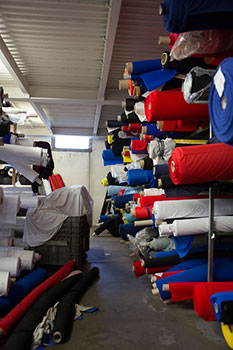
it's not only the desire for any of the world's cycle clothing providers to associate themselves with the country while accessing some of that long-held expertise, but the opportunity to grasp just a smidgeon of that glory to help apportion connoisseurship on the instigator. however, such is the high quality that can be economically accessed in the far east, were italy not successfully maintaining its position at the forefront, modern economics would likely confine it to the manufacturing sidelines. that reputation continues to be thoroughly deserved.
many of italy's clothing expertise is still family-owned with a tradition spanning several generations. it's not just a living but a whole way of life. becasue of this great tradition, they can often call upon a skilled workforce across the many fields of textile production. additionally, it is often not too much trouble to set up looms that allow short production runs of even a highly technical nature.
it has often seemed something of a dichotomy that several of the world's clothing providers do not manufacture their own products, but realistically speaking, not only is it something of a redundant notion to re-invent the wheel (pun not intended), it is surely better to take advantage of the economies of scale and outsource to those who already own decades of expertise. such as the italians, for example. having not the concerns and worries of operating large textile mills and constantly developing cutting edge materials leaves the emerging apparel insurgent free to concentrate on what he/she likely does best...
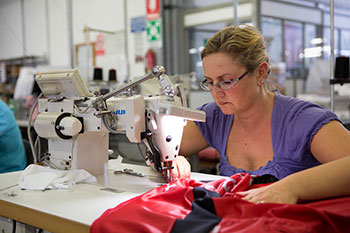
...designing.
cycling is not short of clothing providers; while i have recently paid testament to how well catered for the sport is in terms of quality photographers, it seems just as well provided for when it comes time to clothe the lithe and athletic form. though freedom of choice means it's possible to choose that which matches your individual budget, i can still hear my mother re-iterating the mantra buy cheap, buy twice. in the majority of cases, the cost of buying quality is justified, even if it means purchasing a tad fewer items than would be the case if opting for budget ranges.
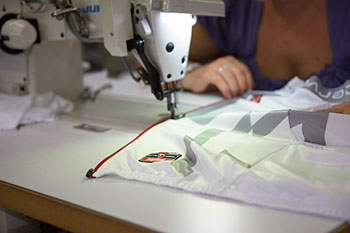
though i cannot truly admit to having found clothing made in the far east to be wanting at any stage of the game, riding a campagnolo equipped italian made steel or carbon frame almost demands a made in italy label either on shorts or jersey or even belgian styled winter cap.
despite the unione cycliste internationale's best attempts to turn cycling into a global sport, incorporating races in africa, the middle east along with regions of china and the far east, the grassroots cycle enthusiast is perhaps more enamoured of the european classics and a tradition that continues to thrive in the face of globalisation. surely a part of this is a continued appreciation of all things italian, not just because of the sentiments expressed in 'breaking away', but because it remains a valid part of contemporary road-cycling. considering oneself an italophile in this day and age is just as relevant as it always was.
as carlyle ware, the brains behind relatively new kid on the block, swiss-based cervo rosso mentioned recently "Made in Italy is not a throwaway line or strap line employed to support our promotional efforts. Made in Italy is a label that makes us proud."
friday 19 october 2012
 ..........................................................................................................................................................................................................
..........................................................................................................................................................................................................picture post

'To take a photograph is to align the head, the eye and the heart. It's a way of life.'
henri cartier-bresson.
i think there little doubt that the photography element of modern cycling is not only more adventurous than much of the imagery ascribed to other sports, but inhabits a level of quality i think it safe to say, exists nowhere else in this sporting life. there's an outside possibility that some are a teensy weensy bit tired with what is seen as the cliche of black and white when colour is all around us, but subjectively, many monochrome imagery carries with it an implicit reference to cycle sport's undoubtedly rich heritage. i did recently hear of a digital camera manufacturer who was about to offer a (rather expensive) black and white only camera, perhaps in response to a growing love of the colourless medium.
my editor and i have often had discussions regarding the quality of the photos submitted for publication. the promise of digital photography has, to our mind, convinced everyone that they're now a photographer, something that is plainly not the case. any photos we receive from a bygone age are of far better compositional qualities as well as, in most cases of a clarity that seems to have bypassed many of our contemporary contributors. there is, of course, a simple reason for much of this; though compact digitals are almost ten a penny, in days of yore, the same was not the case. cameras were owned by those who were studied (in one way or another) and often professional photographers.
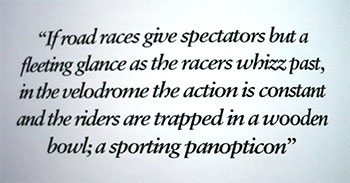
such is the march of progress.
however, many of the greats of photographic history have left an almost unparalleled legacy which, in many cases, have rarely seen the light of day since the time of their conception. photography verges on the wrong side of pointless if it remains unseen.
as mentioned above, cycling is particularly well blessed when it comes to recorded imagery, and it is worth noting that several of those now working in the cycling realm were not brought to light from a sports photography background. it is more than possible that this has helped them avoid the cliched imagery that often inhabits the portfolios of those steeped in cycle sport, treating that which passes before them as anything but cycle racing. i have been vocal (if such is an appropriate account) in the past of crediting this state of affairs to both rapha and subsequently rouleur magazine. their treatment of cycle related imagery may now have become somewhat mainstream, but at point of origin, it was anything but.

rouleur has continued this exploration at one or two points during its career by incorporating photographs taken in a previous era, bringing to our eager eyes, hitherto unknown works by the greats of the genre. in issue 31, editorial director guy andrews introduced the tour de france images of robert capa, and in the most recent issue (rouleur 34), bike show host jack thurston provided written accompaniment to a series of photos by the inestimable henri cartier-bresson taken at the velodrome d'hiver in paris. i asked guy andrews if these stories had effectively fallen into his lap or if he had gone searching for them?
"We've worked with Magnum (the photo agency that represents the works of both) before, with John Vink (issue 3), Guy Le Querrec (issue 9) and Harry Gruyaert (issue 12), so I'd been aware of the cycling stories they had for a long time. I thought that the Robert Capa And Henri Cartier-Bresson stuff would be off limits though, but Magnum seem to like what we do and were very happy to let us publish them."
what is rarely a difficult concern nowadays concerns the circumstances under which the photos were taken. much of the work shown in rouleur and other cycling publications is commissioned, or if not, is part of a proposal by the photographer. thus its provenance is likely well known and that by which it is judged. however, many of the images hidden in the archives at magnum are less well-known, and if considered for contemporary publication may require an unprecendented level of investigation to place in the correct context. had either he or jack thurston involved themselves in substantial research regarding their respective articles and photographers?
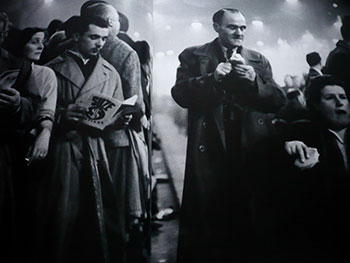
"We both had to do a fair bit of digging, just to get to the bottom of each story. Because they were both unknown as 'sports photographers' there is very little to go on. I think we both did a pretty good job though, of telling the back story that is; it's all in there."
i cannot deny that my day job involves a considerable amount of page layout, some of which suggests its own design, some of which is done in consultation with an editor, and a portion which bears reference to previous publications in which articles or photographs may have appeared. it is not an exact science and it remains to this day, a very subjective art; everyone has an opinion, few of which ever seem to agree with each other. with reference to those robert capa images in rouleur 31, photo stories from paris match featured as a competent part of the illustrative nature of the piece. had those spreads unfluenced the display of the capa images in that issue of rouleur?

"Not at all. Match used only a few from Capa's Tour story and we used most of it. We have a large collection of old reportage magazines kicking around and their design and layout is very varied and they weren't always popular with the photographers of the time - using a few pictures and in a cluttered layout - not much changes in that respect. Picture Post, Vu, Match and Life all had a great hit rate of photo stories though, and you never get bored of looking through them. Capa was on assignment for Match at the Tour in 1939, although it's unclear really why they sent him, as much of the stuff they published in the following issues was by other photographers as well as just a couple by him."
in the world of the visual arts, history often apportions a seemingly disparate group of artists membership of a sometimes arbitrarily named school. the pre-raphaelites, cubists, fauvists, the glasgow boys... the list is almost endless. it was not entirely unususal for painters, and by implication, photographers, to be members of more than one circle. both robert capa and henri cartier bresson were represented by the agency co-founded by both. does andrews see any intrinsic connection between the two photographers, other than their 'membership' of magnum?

"They are similar in that they cared more about 'being there' than the event itself. Cartier-Bresson was perhaps more neutral than Capa was (politically speaking) and Capa was always keen to state that he was more journalist than photographer."
there is an implication, by the very stature of the aforementioned two photographers, that we are staring at a legacy in keeping with their importance in the history of the still image. though of intangible nature, such works have a gravitas that almost overshadows the simplicity of what they are: a record of events. how much of an obligation did guy feel towards both when representing their work in the pages of rouleur? presumably it takes a lot of care and attention to ensure the final print remains as true to the originals as possible?
"We've developed a way of working in Rouleur that is close to the photographer's edit and their layouts are always approved with them before we publish. Obviously this wasn't possible with Capa and Cartier-Bresson, but we have plenty of experience of what works and what doesn't, so I like to think we have their interests close to heart."

as a part of digital photography classes i have taught, it has always seemed important to point out that, certainly in the interests of beginners, the recording electronics inside the camera are of a specific shape, thus recording images that are always and forever of the same proportions. this often results in areas of the final photograph consisting of that which was not desired. hence the crop tool in photoshop. it is entirely unnecessary to always print each image according to the camera's default proportions. however, unless you are someone like me; a poor photographer, but one happy to spend hours in photoshop adjusting that which needs adjusting (usually on behalf of others), it is far preferable to get it right in the camera.
if you have viewed any of the photographs of cartier-bresson, you will have perhaps marvelled, as have i, at the uncanny command the man had over the science of composition. this assumes almost supernatural qualities when you take into account the fact that, unlike digital, there was no opportunity to check the veracity of the image prior to its being developed. at least nowadays, 'tis but a moment's work to look at that little preview screen before deciding whether it might be a salient idea to try once more. however, to cartier-bresson, cropping the image was anathema. was this an aspect of printing his work that had to be taken into account in the current issue?
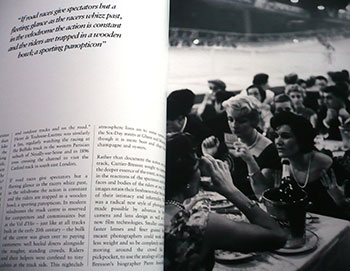
"That is something that we spent a long time considering (including a few sleepless nights!) as just one of the shots, the cover, had to be cropped slightly to fit our format. His feelings on this subject was something that we were fully aware of and we had to have the eventual image approved by the Henri Cartier-Bresson foundation. They gave us permission to use it as we have. We had about 15 versions and placing the masthead created all sorts of bother, but it's proving to be one of our most popular covers, so I think we did OK. The rest of his images all appear full frame, as he would have preferred."
is it important that these images of cartier-bresson have seen the light of day after so many years of remaining 'undiscovered'? "Yes, I guess so. They are there to see on the Magnum website, but far better for them to be published in print and as the full story, than left in a box."
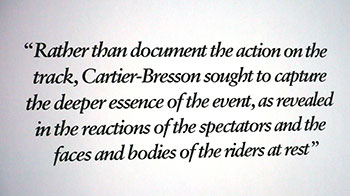
it will have been obvious to readers of both issue 31 and the current issue 34, that both photographers seemed less concerned with the cycle racing per se, than with all that transpired around them. the racing might well be considered a catalyst for the resultant imagery. is this something contemporary photographers could pay more attention to, or does guy feel the lineage has been satisfactorily maintained?
"I think so yes. A bike race is a very rich visual environment for the photographer and there are some exceptional photographers working in cycling right now. But it's worth mentioning that both Cartier-Bresson and Capa nailed it in one hit, that's how good they both were. (BTW, Johnny Green describes Cartier-Bresson's ability to paint the story of a race better than I can here. It's on the issue 34 podcast)"

in the world of digital, entropy is conserved throughout the process, from clicking the shutter, transfer to a computer, to any digital post production that may be deemed necessary. the weak link makes itself known when printing is at the end of the line. depending on the printer profile, printer driver, ink cartridges/litho plate and final stock (paper), quality can be lost that ranges from imperceptible to downright disappointing. it is common practice to apply a varying amount of sharpening to compensate for factors such as dot gain and an almost inevitable loss of quality. however, in addition to cartier-bresson's dislike of cropping, as jack thurston points out, he also figured that photographers were overly concerned with sharpness. is that something hard to avoid in the digital age, both in camera and the vicissitudes of the printing process?
"Style and tastes are always changing and digital technology means 'sharpness' is now pretty much a given. In Cartier-Bresson's era he thought that the quest for technical excellence was a distraction from the main event, and who are we to argue? He was very outspoken and opinionated about photography, especially as his life moved in other directions, but he gained a huge following and a well deserved reputation and when you''e that good it's only right that your opinion matters. These days photography is a much more moveable feast and Cartier-Bresson was working in very unique times, but it's a bit like comparing Merckx with Coppi or Indurain with Wiggins; it's a pointless debate as it's just different - things move on."

i think it all but undisputed that the past can often inform the present, and while rouleur continues to be one of the finest of cycling's contemporary publications, offering a considered and literate view of modern cycling, its frequent delving into the past is of commendable import to the modern day cycle fan. is it likely there are more undiscovered treats in the vaults somewhere, does guy intend to go looking?
"At Magnum there are a couple of other stories we may have a look at, but elsewhere there are many, many photographers' archives that are exceptional and perhaps more developed in terms of cycle racing. Vivian Maier is one that springs to mind. Her work is some of the best I've seen in a long while and it never saw the light of day in her lifetime. We are always looking, and have some very exciting unseen work (from an old archive) that is extraordinary and prolific. Watch this space."
if you haven't already done so, might i suggest you acquire a copy of rouleur 34 for enhancement of your cycling appreciation.
"The decisive moment, it is the
simultaneous recognition, in a fraction
of a second, of the significance of an
event as well as the precise organisation
of forms which gives that event
its proper expression."
henri cartier-bresson.
all images accompanying this article are my own photographs of rouleur issue 34.
thursday 18 october 2012
 ..........................................................................................................................................................................................................
..........................................................................................................................................................................................................wheelsmith
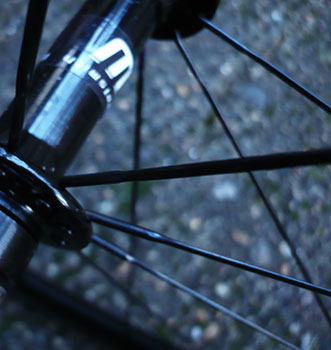
i have already detailed at length the rather circuitous route taken by an innocent pair of wheels from larbet based wheelsmith, but now that they're here, it seems only fair that i propound further upon their efficacy for the job in hand. both 25mm deep, matt black rims and slightly glossier black hubs are wheelsmith branded parts, the latter having been constructed to derek mclay's requirements. the two components are conjoined into a rather impressively stealth looking pair of wheels by means of twenty, black sapim cx-ray bladed spokes at the front and four more at the rear. the flanges of the hubs have been thickened to allow a radial spoking pattern if required. the front is laced in exactly that fashion, while the rear is more pragmatically laced two-cross, as there are differing forces to be dealt with at the back.
derek rather thoughtfully shod both wheels with a pair of schwalbe's ultremo r.1 smooth race tyres which but add to the black stealth appearance. at a retail price (without tyres) of £450, they comfortably undercut the mavic ksyria slr with which they are intended to compete, yet arrive at only a smidgeon over 1400g. i have been at pains over the course of several years to underline what i believe to be the advantages of a handbuilt pair of wheels. though these are more or less a stock item in terms of their build components, the value-add here is the fact that as a potential purchaser, you're working with a builder who can take your riding and human frailties into consideration.
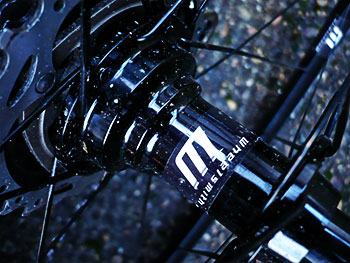
a handbuilt pair of wheels almost always features standard stock spokes, meaning that any breakages can be easily replaced, either by yourself if you're up to that sort of thing, or by returning the offending hoop to wheelsmith. derek offers a 'free spoke for life' service, principally because he's confident that, in the course of normal riding, they simply won't break. faith like this transfers to the ride, as in why should i worry?
the hubs are available with either a shimano/sram pattern freehub or the deeper and chunkier campagnolo version. as i was sent the latter, the wheels have been cheerfully fitted to the colnago master, a bicycle which changes gear via some campagnolo centaur gearing. the hubs feature cartridge bearings rather than the more prevalent cup and cone versions proffered by the corporates. adjustment is via a similar process to that employed by many others including chris king. an allen key in each end twisted in opposite directions will allow removal of the end caps and subsequently the axle and freehub assembly.
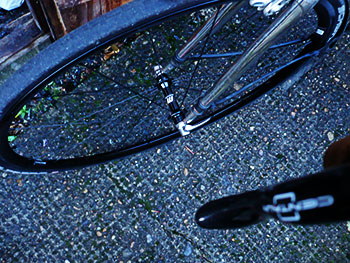
i have proved, to my own satisfaction that, as far as ten-speed systems are concerned, whether the freehub bears a campagnolo cassette or a sram/shimano version seems to have little bearing on the quality of changing at the rear. i realise that there are white coated gents in vicenza and japan now running hither and thither shouting "make it stop", but facts is facts. assuming this state of affairs to remain, i'd be quite happy to fit the selfsame wheels with a campag hub to either my cielo or ibis hakkalugi, both of which feature sram changers. knowing that a pair of wheels can be seamlessly swapped between bicycles rather fills me with joy.
i removed a pair of mavic r-sys slr wheels from the colnago in order to fit the wheelsmiths, gratifyingly noting after having done so, that there was little if any change in the overall weight of the bicycle. a good, well-built pair of wheels ought to have been properly de-stressed by the builder, something i usually remember in the process of leaving the building with relevance to any that i have built myself. if not, the first few pedal strokes will inevitably result in a flurry of ping, ping, pings as the wheels are placed under even light riding stress. up till this point, the wheelsmiths have yet to utter a sound.
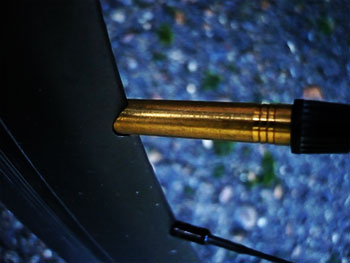
actually, that last statement is a lie. these, presumably due to the depth of the alloy rims, exude an utterly fabulous whooshing sound across any form of tarmac you care to mention. it's the sort of sound that really ought to be digitally sampled and sold to accompany lesser wheels. i can attribute this sound to the rims rather than the wheels, for it seems independent of how poorly i have inflated the ultremos (of which more later).
islay is a wheel reviewer's paradise, aided and abetted by a veritable excess of crappy road surfaces and all too frequent cattle-grids. it makes little sense to pussy foot about, eternally searching for smoother tarmac to save any blushes. if there is a failing in these wheels, i have had more than just a few opportunities to discover them, but so far they have remained resolute of purpose. the road kept purely for special occasions has been ridden in both directions, augmented by a herd of cows who not only fail to clear up after themselves, but seem undecided as to which is the better side of the road to be on when passed by a repeatedly conversing cyclist.
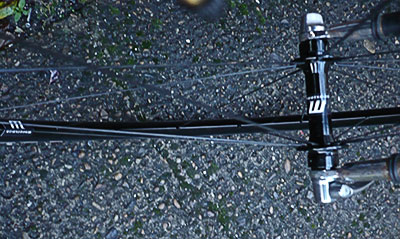
(this latter conversational feature is a safety aspect; you do not want a cow to discover your presence as you pass in close proximity to its hind legs.)
though an experience that can be placed at the door of the bicycle's rear triangle just as nuch as at the rear wheel, i am a great believer in fitting the rear pads as close as i can get away with at the rear, before giving it serious welly in the big ring up a scary incline. if there is any lateral twisting of the wheel, there ought to be rubbing on each pedal stroke. the colnago master features a carbon b-stay which, in my many years of experience, simply doesn't budge under pressure. in this case, neither did the wheel. heavy footedness failed miserably to instil any sense of brake rub.
result.
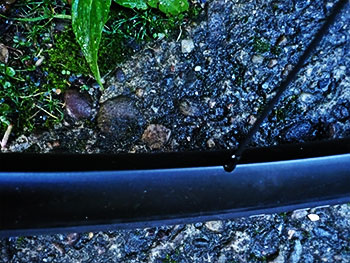
an unhealthy diet of cattle grids similarly had no adverse effect, though the same could not be said of their impact on the rider. i really should know better by now. i unintentionally provided the wheels with more of a challenge than is truly appropriate, perhaps giving derek the opportunity to cite his under normal riding conditions clause had there been any untoward results from my incompetence.
intent on a quick early morning ride before heading into work, i clambered into my secret identity before breakfast, washed the dishes and dragged the colnago kicking and screaming from the bikeshed. the more observant amongst you will have picked up that i have omitted the important check the tyres stage. this sort of came back to bite me as i hurtled (it's all relative) along the abattoirenberg forest, beginning to wonder if i had a slow puncture at the rear. in such cases i figure it's much better to adopt a head in the sand approach until the horrible bump, bump, bump or the valve indicates a serious loss of pressure. that is, embarrassingly, the stance i adopted in this case.
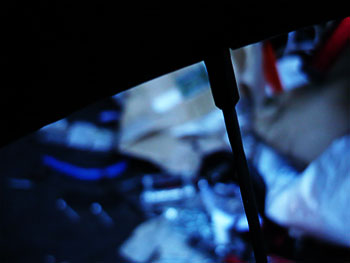
pedalling really hard did not seem to be resulting in even the slow forward motion i would have expected. riding through treacle would be a reasonable simile. soft tyres are never a great idea on a road bike, and on the roads travelled, not the kindest thing to do to wheel rims. the tyres are now inflated to a satisfactory pressure, while the rims bear not so much as a scratch. acceleration is as good as it's going to get for an aging roadie, while the handling is impeccable.
these are really, really good at a disarmingly good price, and the all-black look satisfies my notions of speed. ok, so colour, or lack thereof, hardly promotes unheard of velocity, but i'm a firm believer that if it looks fast, it is fast. basically these offer a superbly handbuilt (in scotland) pair of wheels, with easily maintainable hubs and the promise of free spokes for life, consequent on your not tackling the downhill course at fort william.
my faith in handbuilt wheels has gained bolstering reinforcement, while my secret identity has gained a bigger smile in the process.
wednesday 17 october 2012
 ..........................................................................................................................................................................................................
..........................................................................................................................................................................................................velo - the exhibition part two

it's possibly a case of which came first; the chicken or the egg? i am aware that scientists have recently answered that question once and for all. apparently a protein found only in a chicken's ovaries is necessary for the formation of an egg. but it's unlikely that knowledge of such will have us desist from using the phrase in all manner of unrelated matters. which is partially why i'm using it here. though certain quarters of our little niche world would quantify cycling as a sport, there are as many, if not more, who regard it as an activity. subset within this latter group are those who look upon cycling as a necessitous activity that will allow travel and/or commuting. none of us are wrong, and none of us are right.
in a twist of philosophical thought concerning the where does my lap go when i stand up? school of thinking, until the bicycle is being ridden by a cyclist (something of a tautological progression, i'm sure you'll admit), they are but two separate entities: bike and rider. once cycling has taken place, though composed of the two individual articles, there is now a third and that is the important step that opens itself up to all forms of possibility. for we now have an ideal that is independently categorisable by the less than innocent bystander.
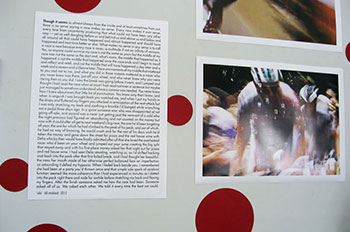
place a collection, or peloton, of cyclists on a pre-defined route and offer a prize for the first to the finish, and you have a race. do similar, but offer no tangible prize, and it is looked upon as a sportive. there are all sorts of alternatives within the basic premise, but i think you likely catch my drift so far. bicycles are intriguing, not solely due to their ubiquity; many will have picked up on the news that italy sold more cycles than cars last year; but in the light of their intrinsic simplicity, beauty and defiance of apparently sound gravitational properties.
how come left to its own devices, a bicycle will always fall over, yet add several kilos of rider and put it in forward motion and it'll carry on for miles. that is the perennial quiz, though not always for cyclists. that part is taken for granted.
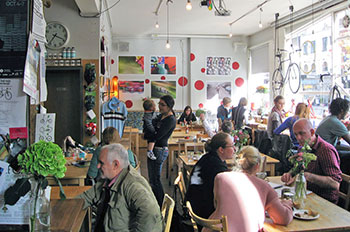
however, cycling's profile is likely at its peak in the form of sporting prowess watched either 'in the flesh' so to speak, or more likely on television. in this way there is a recognisable entity that can not only form the basis of further investigation, but one that would appear to have a ready-made audience. i have borne witness to one or two cogent displays that have inhabited the superficial, due either to a lack of serious intent or thoughts of an easy ride (if you'll pardon the pun). such is by far not the case with andrew smith's velo-adventures of the peloton. you may recall that i brought his collection of astutely observed imagery grabbed from the television screen when it exhibited in sheffield earlier this year. in fact, so popular was the show that it's period of exhibition was extended past the initial deadline.
in keeping with the regular aspects applied to exhibitions of many differing subjects, the imagery was encapsulated in an accompanying book, in this case, printed in a limited edition. now the exhibition has mutated in the nicest possible way to look mum no hands! in old street, london, accompanied by a second limited edition book. by all accounts, exhibition number one was a runaway success. had andrew made any changes for the second event?
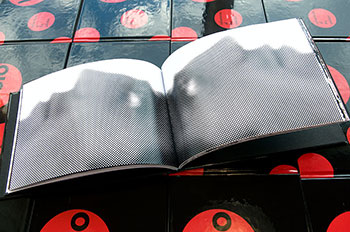
"Yes, the first exhibition in Sheffield was very well received, but it was always my intention to take the opportunity to be creative, and make changes for the second one. I think that the major difference between the two is that Sheffield was very much a curator-led selection, and we attempted to emphasise certain underlying themes that were evident in the larger set of images.
"Themes such as the endless fantasy world of sunshine that the Tour represents for a lot of viewers who may be sat in a rainy, grey city somewhere watching the TV coverage. For this second exhibition, I wanted to lose any such constraints and try to get a bit closer to the core of the work, to try and materialise those original feelings I had about the photographs and Tim's words that I had in my head. Obviously I did have some constraints because the display needs to harmonise tonally, and this does impact the selection. So, of the eleven images in the LMNH display, one image remains from Sheffield, and there are four images that are new and not in the book, plus Bill's text is on the wall."
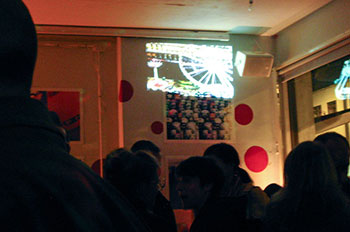
the exhibition itself perhaps asks as many questions as it answers, providing a mirror to show its prospective audience just how it consumes its cycling. painter roy oxlade, at one time an acolyte of david bomberg, has long maintained the efficacy of symbols (as opposed to symbolism). he has been content to paint almost childlike figures, chairs, electric fires, flowers etc rather than become a slave to realism. his valid justification for so doing is based on our own cognitive values; we know just what a human looks like. and also the appearance of a bowl of flowers. thus, everything else is simply a demonstration of facile technique.
thus, any criticisms of smith's work so far would appear to miss the point. his television imagery not only depicts symbols that we inherently recognise every day for three weeks in july, but demonstrates the apparent lack of televisual quality with which we are happy to live. stopped mid frame, the images are decidedly low-fi.
with no disrespect to andrew, he is not quite a household name, even in the world of cycling and it can have done this second incarnation no harm whatsoever that bicycling editor and consummate writer and author bill strickland has provided the accompanying book's superb introduction. how did that happen?
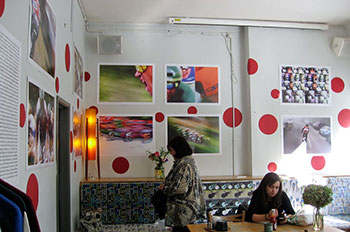
"Well, I first contacted Bill on a cold-call basis when I was looking for people who might have been interested in hearing about Velo. I also contacted Luke Scheybeler in a similar manner, and he very kindly recommended Velo to Bill, who subsequently bought a copy of the first edition. He then reviewed the book on his blog.
"I just loved the nature of the review, the craftsmanship of the words, and how he got straight to the heart of the book. When I decided to produce the second edition I sent the PDF to Bill and asked him if he would be interested in writing a piece for the front, and he generously agreed. I really am honoured and proud to have those words in the book. It's an outstanding piece of writing in that it just fits like a glove. I find it beautiful and thought-provoking, and I think it's the perfect overture. It has finalised the Velo book."
having planned and organised an exhibition of any import, size or quality, it's difficult then to incorporate any mide-season changes in response to audience reaction. similar considerations must also be incorporated into the book. it's perhaps a more reasoned approach to observe the initial foray, all the while taking mental or written notes of the things you'd do differently if a second time materialised. that second time opened at lmnh on saturday along with the red and black covered, compact and bijou book. has the second volume received any changes from the first?

"Yes. From the outset, from the first handmade edition of one copy, I was always thinking of how to evolve the book. I love the concept of the artist book, where the book is the art object; it opens up so many possibilities. The first printed and bound edition was intended to be almost a fanzine style production; lots of images and ideas, and references from a variety of sources put together with a seemingly apparent lack of discipline. For this second edition I really wanted to tighten up the work and bring it into a more 'traditional' photobook layout but with no compromise at all in the content, maybe even make it a little darker in feel. The revision has removed around 40 images, the sequencing is different, and there are a few new images in there. Physically the book is now casebound with a new cover design, and of course Bill's introduction binds it all together."
as one who has spent a lmany a happy hour visiting art and photographic exhibitions, there is often accompanying printed matter that serves almost solely as a souvenir of having visited the exhibition. granted, some contain more than simply a precis of the pictures on the wall, filled with accompanying scholarly text that might conceivably provide an education
 in and of itself. there are far rarer occasions where print has been considered as an entity all of its own, one that could be comfortably read and viewed in complete alienation to that of the pictures on the walls. is velo the book designed as a memento of the exhibition, or does it fulfil a more complementary function?
in and of itself. there are far rarer occasions where print has been considered as an entity all of its own, one that could be comfortably read and viewed in complete alienation to that of the pictures on the walls. is velo the book designed as a memento of the exhibition, or does it fulfil a more complementary function?
"That's an interesting question as Velo was conceived as a book, but I suppose the book is a memento of the exhibition should you visit it. I think that Velo has developed over the last year to become a piece of work that encompasses a book, wall mounted prints, and a video element."
from small beginnings at a summer exhibition in sheffield to the hallowed walls of look mum no hands in the same season can be viewed in few other ways as something of a success. i have a copy of the book in my possession, and it honestly has to be said that the photos and commentary provided here do not do it justice. there is, within its innards, a double-page spread of eddy merckx's head in profile, printed black on white using a very low line-screen (big dots). the black ink offers up a raised profile to prying fingers, providing an unexpected tactile experience. perhaps unintended, but neat all the same. several of the images take on an abstract hue, whether by their curtailment through page size, or simply displacement from their natural habitat. imagery into art.

it's an intriguing body of work that andrew seems commendably willing to let adopt its own visual level, refraining from dogmatic constraint upon a changing background. does he hope to take the exhibition to other locations in the near future?
"If people in other locations would like to see the exhibition I would love to take it to them. It's an honour for me to be able to show this work and have people see, think, and express their feelings about it. Obviously there are financial and logistical concerns in taking it places, but if there's a will and they can be overcome..."
velo - the adventures of the peloton runs at 'look mum no hands' until 26th october, the eighty page limited second edition of the accompanying book is available at a cost of £24 from velo the book
tuesday 16 october 2012
 ..........................................................................................................................................................................................................
..........................................................................................................................................................................................................